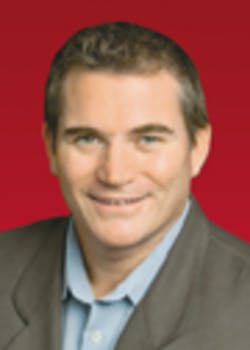It's like the old joke: “Meaningful use? You can't get there from here.”
For our April issue, HMT put together a roundup on “Implementing Meaningful Use Objectives,”
asking selected industry experts for their input.
Meaningful use is a noun, not a verb
By Kevin Ketzel, national vice president, dispensing technologies, CareFusion
The meaning behind meaningful use is achieving sustainable improvements in healthcare quality to help deliver the Centers for Medicare & Medicaid Services (CMS) vision of better patient care at a lower cost. Heath IT and secure health information exchange between providers and medical devices across the episode of care is core to transforming our delivery system. Electronic health records (EHR) adoption and electronic reporting of clinical quality measures is the starting point.
The full scope for meaningful use should be more clearly articulated now so stakeholders understand what is expected of them to reach the end goal of a National Health Information Network. Stages 2 and 3 criteria should be defined earlier than currently anticipated. It's critical that implementation allows sufficient time to ensure newly interoperable systems and devices are functioning correctly and optimally connected to avoid medical errors and eliminate inefficient workflows that create unnecessary costs.
The U.S. healthcare system's future will be defined by how we use IT to enable better data capture, quality improvement and population-based patient care. Meaningful use is significantly improved for all stakeholders when medical devices and EHRs have achieved interoperability. The early stages of meaningful use appear to have overlooked some building blocks for device interoperability and actionable intelligence across the patient episode of care. To deliver on the promise of better care at a lower cost, it's imperative we recognize meaningful use is a noun, not a verb. Meaningful use describes a place we are going with health IT.
Tackling the meaningful-use challenge
By Robert Connely, senior VP, innovations, Medicity
The healthcare map of the United States is dotted with white spaces — clinically underserved areas characterized by above-average rates of chronic illness and below-average clinical outcomes. The health IT infrastructure in these regions tends to reflect the economic climate: EHR adoption is low and providers have limited funds for adoption.
The Office of the National Coordinator (ONC) took this and similar scenarios into consideration when defining the rules for achieving meaningful use of EHRs. The result is the inclusion of modular approaches in the range of technologies that can be certified for meaningful use. The availability of lower-cost, modular technology — combined with the availability of complete, traditional EHRs — provides options that both appeal to and are accessible to all providers.
The modular approach enables providers to tackle the meaningful-use challenge one requirement at a time rather than necessitating a large-scale cutover from paper records to a full EHR. Meaningful-use modules represent a sound option for cash-strapped providers — with costs coming in at a fraction of the $44,000 government incentive — and can be quickly implemented in a practice without requiring workflow redesign.
The modular approach offers unlimited possibilities for providers to keep tackling reform bit by bit — implementing capabilities as needed to improve workflow and increase quality care.
New era, new requirements: data loss prevention
By Sadik Al-Abdulla, senior manager, security solutions, CDW
Half of patients in the United States believe that electronic health records will have a negative impact on the privacy of their personal health information (CDW Healthcare, “Elevated Heart Rates: EHRs and IT Security,” March 2011). Whether those concerns turn out to be prescient or paranoia is largely based upon how healthcare organizations respond to the new security requirements of the EHR era.
Without question, the cyber criminals are ready; the illicit market for personal information is growing at 500 percent a year. Yet, according to a 2010 Ponemon Institute study, 88 percent of data breaches were caused by employees making simple mistakes in handling data or broken business processes. By fixing the basic cultural and business process problems, IT security staff can then turn their attention to the real threat: malicious fraud.
Though preventing data loss does require investment, the return to the organization in terms of risk mitigation is significant. According to the same Ponemon Institute study, the average cost of fixing a data breach is $6.7 million, and that is just to address the technology. It does not include the impact to corporate reputation, loss of customers, legal fees or restitution.
EHRs are not inherently less secure than paper records, but they do demand a different approach to protecting data. To start, engage data owners to build a stakeholder group with the gravity and resources to make meaningful changes to the organization's processes. Then, work with a trusted technology partner to conduct a data-centric security assessment to clearly understand where your organization's data is most at risk.
In the end, most organizations find that the biggest risk is not the foreign hacker — it is organizational inertia.
The key to qualifying for Stage 1 is in the cloud
By Oleg Bess, M.D., CEO, 4medica
As hospitals prepare to meet the requirements of meaningful use, they are realizing that they are in immediate need of flexible clinical integration solutions to help them link disparate systems and electronically exchange health information. To add to the pressure, they are up against a looming deadline for Stage 1 and slim budgets to implement new healthcare technology.
Whether or not a hospital has an existing electronic health record, establishing connectivity and interoperability with other providers' systems and ancillary services will be extremely difficult — especially doing it in time to qualify for Stage 1 or even Stage 2 incentives.
Hospitals without an EHR: Unfortunately, these hospitals have to face the reality that they may not qualify for Stage 1 incentives even if they sign on with an EHR vendor today. This is because traditional EHR implementations can take up to a year. Combine that time with the 90 days of meaningful use required by law, and hospitals will be cutting it too close or they won't meet the deadline to qualify for Stage 1 incentives at all.
Hospitals with an EHR: Several hospitals with existing EHR solutions have system gaps that hinder their ability to meet the standards for clinical integration. Many EHR vendors are addressing this issue. The problem, however, is that the vendors are backlogged with demands for meaningful-use-compliant implementations, putting many hospitals on a waitlist that hinders their ability to upgrade their systems in time to qualify for Stage 1 — and in some cases, Stage 2 — incentives.
The key to solving this problem and electronically exchanging health information in time to meet the 2012 deadline is in the cloud. Clinical integration solutions that leverage the cloud and software-as-a-service (SaaS) technology can act as the “glue” that links existing healthcare IT together. Whether or not a hospital has an EHR, this type of technology can integrate data from multiple sources and institutions using standards specified in meaningful-use criteria to act as a patient-centric integrated health record. And, because the Web-based technology acts as middleware — sitting on top of existing healthcare IT solutions — it can be implemented in just weeks, giving hospitals a comfortable cushion to meet the Stage 1 deadline.
Meaningful use entails more than EMR implementation
By Keith Slater, VP and GM, Henry Schein MicroMD
The advent of meaningful-use requirements has compelled many practices to accelerate plans to implement an electronic medical record (EMR). In their rush, however, it's vital they not overlook one critical point: ONC-ATCB-certified EMR systems, in and of themselves, do not assure meaningful-use compliance or qualify practices for incentive pay. While serving as an essential foundation, EMRs are simply tools. Practice leadership must ensure they're being wielded appropriately to achieve the overarching objectives of the mandate.
Here are three recommendations to facilitate meaningful-use success:
1. Construct the EMR implementation plan carefully. It certainly will encompass software installation and basic training. But to ensure long-term success with the EMR, the plan must also include specific training in how system functionality supports meaningful-use efforts. This may include altering workflows or documentation habits so important data can be easily aggregated, reported and analyzed.
2. Engage clinical staff from day one. Involvement will drive adoption. More importantly, caregivers invited to help design necessary workflow changes will be more likely to follow the new approach — and accelerate progress towards achieving meaningful use. Offensive, proactive compliance is actually easier and will achieve compliance sooner rather than retrofitting, reactive monitoring of clinician data entry. Documenting your organization's policies and adopting EMR procedures to complement the policies is a best practice.
3. Monitor progress and provide “remedial training” if necessary. Go-live is not the end of the process; it's just the beginning. Practices will need an ongoing strategy to check that information is being entered correctly. Because it will be tempting for providers to revert to familiar habits, it's vital that concerns are identified and corrected as soon as possible.
The devil is in the details: Providing electronic copies to patients
By Steve Emery, director of product management, HealthPort
Release of information (ROI) is a hidden process in healthcare. Managed in health information management (HIM), the process consists of 32 steps, some of which are regulated by HIPAA and state law. Patients, attorneys, insurers and other third parties request records from HIM. Once a validated patient consent is received, ROI professionals reproduce and release the records. Sounds simple, but the devil is in the details.
Under meaningful use, ROI is a core objective for both hospitals and eligible professionals. We must support the process of providing patients with electronic copies of their health information upon their request. The process must provide those records within three business days.
HealthPort, an ROI services provider, faced a potential dilemma under meaningful use. We already deliver thousands of medical records to patients every day, and in electronic format. But our system is not an EHR.
So we asked CMS whether a non-certified software application or portal could be used to deliver copies of medical records; and whether a human-readable format is all that is needed to satisfy meaningful use. The answer was yes to both questions, as long as the information produced came from a certified EHR.
Not only is HealthPort the delivery medium, but we also tally meaningful-use results for our customers. Our challenge was to follow through with CMS to get the level of detail and interpretation we needed. In response to customer requests, HealthPort is currently in the process of certifying its ROI software as an EHR module.
ROI technology may or may not be an internal system. ROI staff may or may not be employees. However, you are required to deliver electronic copies to patients. In the end, HealthPort believes that by providing ROI software certification, we can increase our customers' peace of mind … for at least one of the core requirements.
Quality, meaningful use and EHRs
By Tom Darr, M.D., CMO, physician solutions, Ingenix
Physicians have two fundamental goals: to provide excellent, constantly improving patient care; and to help drive the transformation of the healthcare delivery system. The ability to measure the quality of patient care accurately and efficiently is central to each of these goals. An obvious starting place for these capabilities is the electronic health record, which is an under-utilized technology.
The U.S. federal government is encouraging adoption of EHRs with special Medicare and Medicaid incentive reimbursements to eligible providers who demonstrate meaningful use of the technology. Nearly one year after regulators defined meaningful use, scores of physician practices are implementing systems they hope will help them improve patient care, manage their workflow more efficiently and control costs.
A focused look shows meaningful-use criteria — core and menu requirements, each with specific metrics focused on clinical care — are rooted in basic tenets of constant quality improvement. They provide careful, specific direction that adds value now and sets up provider practices for even bigger gains in the future. The goal of the criteria is to help physicians use health IT in a way that meaningfully changes how they engage patients and provide care.
Obtaining health intelligence that enables doctors to improve quality is what meaningful use is all about. It supports the critical goal of transforming what currently is a reactive disease management system to an efficient, proactive health system focused on patient health and well-being, including early detection and even prevention of diseases.
Access control and audit: managing generic accounts
By Mac McMillan, CEO, CynergisTek
All certified EHR technologies, in order to meet and demonstrate meaningful use, must have functionality to control access and uniquely identify users to enable effective auditing. When conducting the required risk analysis, many are discovering that generic accounts can create an unacceptable risk. Generic accounts can include service, training, testing, student and vendor administrator accounts and, in some environments, number into the hundreds. While there is a legitimate purpose for these types of accounts, they should be strictly limited, tightly controlled and audited regularly.
Your access control policy should require, for each account of this type, a validated business need. The ability to create/enable these accounts should be strictly limited to a few individuals. All requests for such access should be reviewed, include a time period required and the identity of the requester/user. A maximum time should be established for the account requested being active, and automated controls should be used to enforce time limits/deactivation. Lastly, the policy, process, controls and actual access should be audited regularly to include those administrator users authorized to create/enable such access. Whether regular user or generic account, all access should be managed to the point that access can be tied back to a specific individual. The first step to accomplishing this is conducting a critical review of all accounts and eliminating those that aren't specifically required. Generally, this eliminates many of these accounts and reduces risk. The rest will need to be managed.
Narrative documentation key to meaningful use
By Don Fallati, senior VP, marketing, M*Modal
A cornerstone of meeting meaningful-use objectives is producing consistently high-quality documentation — regardless of the source. Many healthcare organizations are grappling with two related facts: First, from up-to-date, problem-list maintenance to status tracking to clinical decision support, considerable amounts of information needed to meet meaningful-use criteria are captured in voice-driven narrative documents rather than entered directly in the EMR. Second, physician resistance remains high to the constraints of structured documentation imposed by EHRs: workflow disruptions and limited ability to capture the collaborative intelligence that doctors prize as a meaningful supplement to the basic clinical data elements. A bottleneck results on the road to meaningful use and broad EHR adoption.
Organizations are turning to “structured narrative” to bridge this gap between narrative dictation and structured data entry. When tightly coupled, the advanced technologies of speech recognition and natural language processing understand the meaning as well as the words of physician dictation and transform them into information that is computer accessible, structured and encoded using standard medical terminologies. This approach goes well beyond today's simple accommodation of speech into EMR systems, producing higher-quality documentation not only to satisfy Stage 1 meaningful use but also to drive effective clinical actions and create the foundation for meeting Stage 2 and Stage 3 criteria.
Workforce management solutions help deliver quality care
By Brian Graves, global practice leader, healthcare, Kronos
Hospitals and healthcare systems across the country are facing an array of challenges in pursuit of meaningful use to deliver higher-quality care and avoid Medicare penalties, which begin in 2015. While many organizations focus on the implementation of electronic health records to improve outcomes and maintain revenues, workforce management is also an integral part of any organization's clinical and financial strategy. Optimizing the workforce is a critical part of operational initiatives that can support the delivery of quality care, which can simultaneously reduce the cost to deliver it.
In a 2010 CHIME survey (“Report: Meaningful Use Criteria = Health IT Staff Gaps,” CMIO.net, Aug. 24, 2010), staff levels/capabilities was one of the top three concerns of 49.1 percent of respondents. With a comprehensive workforce management solution, organizations can gain visibility to information that supports the best decisions to hire and staff effectively to deliver high-quality care. It can also provide insight into productivity and distribution of labor to workload that allows managers and executives to flex staff up or down to better meet patient demand while maintaining reasonable costs to deliver care, typically saving even small organizations millions of dollars.
Ultimately, in a healthcare environment people care for people. While meaningful use has taken the spotlight, and rightly so, many smart healthcare organizations are also optimizing the workforce — their largest controllable expense — as well as their biggest asset to achieve the delivery of
high-quality care.













